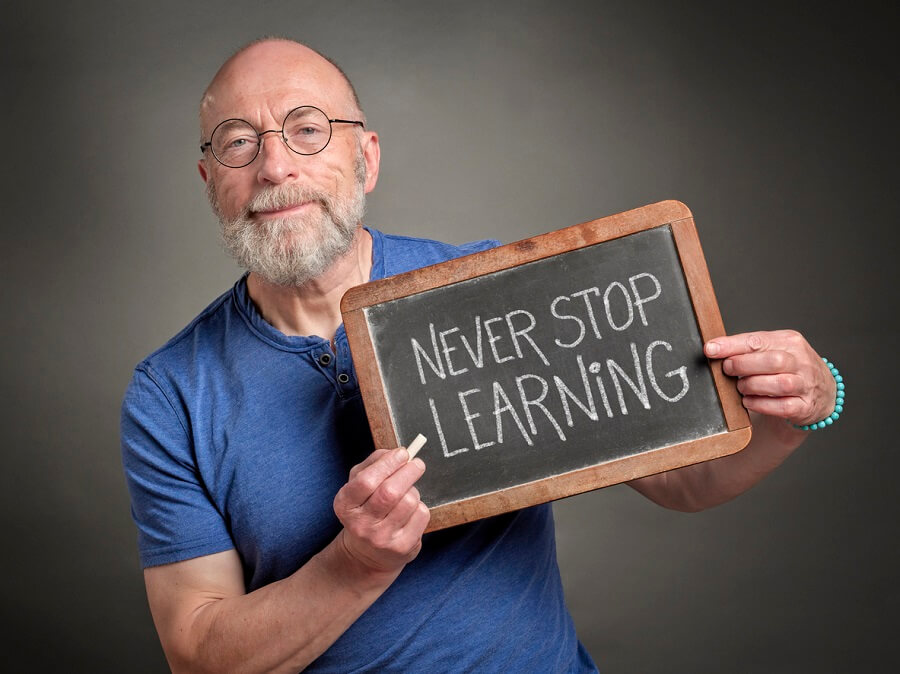Why Does Professional Development Improve Teaching?
Professional development (PD) is acquiring new instructional and leadership techniques through continuing education and career training. Teachers take up professional development to refine their practice and widen their understanding of educational matters as educators.
Continual professional development is vital for teacher success in the educational field. Through professional development, teachers acquire skills and certifications that place them in a better position for promotive roles and increased salaries.
This article will reveal the importance of professional development for teaching, and how educators can use PD to improve their teaching.
Professional Development & Teaching
Investing in yourself is the best way to ensure your student's career and academic growth– especially fostering student achievement. Teacher professional development focuses on improving instructional methods for teachers and improving learner performance.
Educators may experience bumps, especially in their first year of teaching. Professional development allows teachers to prepare and address the challenges that might arise.
Taking up a professional development course expands your skill set and builds your “teacher toolkit,” so you have all you need to start your career strong.
Through teacher professional development, you can expect the following outcomes:
- Expansion of your knowledge base
- Confidence boost
- Networking opportunities
- A better understanding of your goals and enhanced ability to realize them.

Ways Professional Development Improves Teaching
As an educator, you should bridge the gap between different student learning abilities and paces in the classroom. Professional development helps you acquire individualized learning skills through a teaching strategy that improves learner outcomes.
With professional development, your understanding and efficient use of different teaching methods and strategies grows.
You also understand how your students learn, and become better at curriculum instruction.
Your daily roles in teaching range from student evaluations, lesson preparations, and other involving activities. Professional development will provide valuable strategies to help you communicate, organize, and better plan your daily tasks.
Professional Development Objectives
Most teachers take part in some form of professional development annually. Teachers can engage in formal or informal professional development. Informal professional development includes activities such as; peer learning initiatives, reading a book, or conducting independent research.
Formal professional development activities may include:
- Workshops– Workshops will allow you to improve your critical thinking and problem-solving skills for efficiently completing tasks. In workshops, you will learn diversified teaching strategies, technology integration strategies, and emerging trends in education.
- Conferences– Teacher conferences are meant to enlighten you about current innovations. They also allow you to connect with other teachers outside your school district or state. ‘
- Teacher seminars– Seminars are training sessions that will help you become a better teacher in planning your time and being organized. They, therefore, will help you become more efficient, giving you more time to focus on your students and not the paperwork.
- Teacher retreats– Retreats will help you to think intentionally about your teaching processes and their impact on student learning.
Here are the professional development objectives for educators.
1- Positive Behavioral Interventions and Supports or PBIS
Positive Behavioral Intervention and Support (PBIS) directs the implementation of evidence-based programs, practices, and strategies for learners' support. Their goal is to enhance academic performance, minimize problem behaviors, and create a positive school culture.
Professional development will guide in effectively using proactive and positive interventions to meet learners' unmet needs or other problems that interfere with their individual and collective learning.
Professional development training will also guide you into capitalizing on student strengths and achievements by applying these interventions and supports.
2- Response to Intervention or RTI
Response to intervention involves using targeted teaching to identify and assist children struggling in school.
In this response to intervention, students continue to get their core instruction in the collective education classroom. Extra time is allocated to help those who need to catch up with the rest.
The significance of response to intervention is that it is not a wait-and-see approach, as students acquire extra help before they fall far behind their peers and have to repeat a grade.
An essential segment of response to intervention is progress measurement, which helps determine strategies that are not working and ones that can be relied upon.
3- Developing analytical skills
Professional development will enable you to acquire analytical skills. This is the ability to critically analyze information and decide what is significant to a particular task.
Professional development will also guide you toward acquiring other relevant skills, such as research, problem-solving, and critical thinking skills.
The significance of acquiring analytical skills is that you can analyze challenging classroom situations, such as identifying a problem, figuring out the cause, and finding suitable actions to address the situation.
4- Training in specialized teaching methods
As a teacher, you need to familiarize yourself with the right strategies and techniques that you can use to make the learning process interesting.
Professional development teaches you to integrate such learning techniques, effectively marrying them with the individual learner's needs and abilities.
Also, through professional development, you acquire skills to appropriately leverage technology to improve access, participation, and learner engagement.
Here are some strategies to guide you into effective teaching:
- Developing lesson plans using the multi-scenario approach.
- Monitoring and verifying learner responses during lessons.
- Evaluating and adapting your lessons to learner needs.
- Engaging peers to review your lesson plans and suggest ideas to enhance instruction.
- File a list of teaching resources, such as lesson plans, syllabi, and professional development.
5- Leadership skills
As the National Board for Professional Teaching Standards asserts, teacher leadership is essential to a teacher's job. Teachers act as mentors who coach and communicate expectations.
Over the years, you’ll gain experience in inspiring learners and others around you, making them feel safe to speak, and challenging them to think. But, professional development sessions can be invaluable in helping you grow these skills.
Additionally, through professional development, you learn to embrace your leadership roles, communicate effectively, take initiative, and share your knowledge.



What Teachers Seek from Professional Development
For professional development to meet its goal of improving teaching, it must provide what the teacher needs.
There is a common misconception that teaching is easy because teachers are in the classroom for less than eight hours a day and that they have the summers off. On the contrary, teachers invest lots of time and energy which needs to be respected.
Teachers won’t hesitate to complete relevant coursework if it's significant to their time in the classroom. But, you would love some choice regarding what and when you study.
In teaching, you give your best and perform up to standards. However, your success can be reflected in something other than learner test scores. You can then measure your performance using learner perception surveys and teacher feedback forms.
Feedback from the students, parents, and your school administration gives you an honest insight into your performance. It will also provide you and the learner with evidence about your current knowledge and skill development.
This guides you into making decisions about the next steps in the learning process. Learners also reflect on their learning processes and strategies to confirm or adjust them to improve learning.
Feedback and recognition of your input will also motivate you as a teacher.
Ultimately, it will help you understand what works and what does not.
How Students Benefit from Better Teachers
The most significant impact of your professional development process is that it influences student learning. With the continuous change in educational technology, curriculum standards, and school district requirements, professional development creates an avenue for you to keep up with these trends.
Professional development transforms you into a better teacher by guiding you into creating learning materials and curriculum instructions that are carefully adapted for today's learners.
According to the U.S. Department of Education's Institute of Education Sciences, student achievement can grow by as much as 21 percentile points when teachers participate in well-curated professional development programs.
Investing in yourself as an educator is also investing in your students.
Here are some ways in which teacher professional development benefits students:
Improves Student Engagement
Your professional development can improve learner enthusiasm for learning. Their enthusiasm for learning enhances their acquisition of new knowledge and skills. Some of the ways you can improve learner engagement are:
- Setting clear goals- Your learners will perform better knowing exactly what is expected. Professional development teaches you how to set and communicate explicit learning goals in a manner that learners can relate to. This captures their attention and interest in the learning process right from the beginning.
- Enhancing student convenience to learning- in recent times, keeping learners engaged and motivated is necessary for learning. Convenience in learning ensures that learners can access learning materials and content anywhere, anytime. Access on portable devices, both online and offline, improves access and hence the convenience of learning.
Allows More Individual Instruction
Individual instruction allows learners to learn at their own pace with your guidance as an educator. The learners still work towards complex learning outcomes. You must provide your learners with ways to show their acquisition of positive learning outcomes.
You can ensure successful individualized instruction through the following:
- Know your learners- Understand what makes a learner unique. Identify your learners' individual strengths and intellectual capabilities. These will guide you into using appropriate innovative strategies to meet their needs.
- Guide learners in setting individual goals- Your learners should have measurable and realistic goals. The American Institute for Research opines that individual goal setting gives students a sense of direction and purpose which can help build their intrinsic motivation.
- Applying optimal instructional approaches for every learning style- Although there is no one-size-fits-all approach to individual learner instruction, you can choose a suitable approach based on the learner's age, class size, interests, and abilities. But you can also intertwine components from various instructional approaches.
- Leverage technology to improve individualized instruction-You can use assistive technology to help meet your student's learning needs. You can apply more engaging and relevant, personalized learning experiences using technology.
Mobile gadgets such as computer programs and tablets allow learners to learn at their pace, efficiently adapting to their ability levels and skill.
Helps Students and Teachers Connect Better
Professional development will guide you in creating opportunities for collaboration with your learners. When your students learn to connect and collaborate with you and other learners, they appreciate the value of the classroom community.
Such a community helps learners see that all people are important and have something to offer in ensuring the success of all.
With better connections between you and your students, you can expect the following benefits:
- A better understanding of your learners.
- Increased learner participation, hence improved performance.
- Better feeling of appreciation among learners.
- Learners are more free to express their thoughts inside and outside the classroom.
- Presence of a mutually interactive and exciting learning environment.
Continuous Professional Development
Continuous professional development is important because it keeps your skills relevant and your motivation at its peak. It will help you improve your understanding of delivering effective curriculum instruction.
It also teaches you how to adapt to the learner's changing needs. Continuous professional development provides opportunities for upskilling and self-development.
Ongoing professional development will keep you up-to-date on new findings on how children learn, new curriculum resources, and emerging technology strategies.
With the ever-changing educational needs and learning systems, the best professional development is continuous, collaborative, experiential, and connected to the learners and their cultures.
Wondering where to start? We offer professional development courses for individuals and school districts through flexible classes that will help you succeed in today’s classroom. Sign up for free now and increase your student success.
Categories
Latest posts
Sign up for our newsletter


